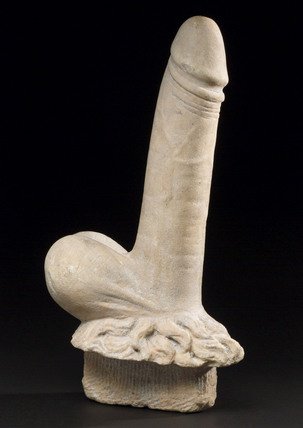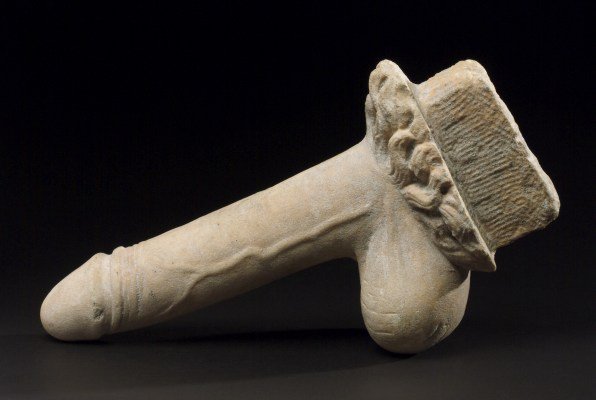Thread by Dr Rob Collins, FSA
- Tweet
- Feb 20, 2023
- #History
Thread
📢NEW RESEARCH of a disembodied wooden #phallus of Roman date found @Vindolanda and published in @AntiquityJ. Here’s a breakdown of the key points and takeaways, a 🧵
www.cambridge.org/core/journals/antiquity/article/touch-wood-luck-protection-power-or-pleasure-a-wood...
www.cambridge.org/core/journals/antiquity/article/touch-wood-luck-protection-power-or-pleasure-a-wood...
First, credit where credit is due. This is a research collaboration between me, Rob Collins, (@ArchaeologyNCL) & Rob Sands (@ucdarchaeology), with great support from @VindolandaTrust
As far as we know, it is the first phallic object of its type and form from the Roman era. The phallus is about 6.5 inches long (160mm), hand carved with a knife or small blade from a young branch of ash wood. Its archaeological survival is unique.
Phallic objects are common in the Roman world, as larger carvings in rock or smaller pendants in bone or bronze, or depicted in art. When presented like this, the phallus has a ‘magical’ function, as a symbol that evokes protection. Search #PhallusThursday for great examples!
The Vindolanda phallus was found in the fill of a late 2nd century AD ditch around the Roman fort. Anaerobic deposits at Vindolanda have preserved a wide range of organic materials such as wood, leather, fabric, and the famous Vindolanda writing tablets.
www.vindolanda.com/blog/fact-file-writing-tablets
www.vindolanda.com/blog/fact-file-writing-tablets
Fortunately, the wood seems to have preserved well, retaining its overall shape without distortion across the centuries, though it has probably shrunk a little. Unfortunately, the findspot of the wooden phallus – its context – does not help us interpret the object’s function.
So what IS the wooden phallus? What did it do? How was it used? We must deduce function from clues on the object itself, especially as it has no parallel from other Roman sites. Looking at the object, we can attempt to infer its function from wear patterns.
There are two areas on the phallus where the wood is smoother, worn through repeated friction: on the domed base and to one side of the glans and upper shaft (in green in the image below). In short, what sort of object has greater wear at each end, and very little in the middle?
We propose 3 possible functions. First, it could be a projecting component of a larger object – a phallus inserted into a statue, a herm, or a building. Second, it could be a pestle for grinding ingredients. Third, it could be a dildo. Let’s look at some examples!
Projecting component – herm (1a): boundary stones / posts in the Greco-Roman world, often bearing a phallus. Wooden examples are not known, but are a possibility, and a separately carved phallus would be easier than one carved from the main post.
www.britishmuseum.org/collection/object/G_1805-0703-24
www.britishmuseum.org/collection/object/G_1805-0703-24
Projecting component – statue (1b): Wooden statues and figures could have a separate phallus inserted into a socket on the main body, as in this grotesque figure from Roman Germany.
Projecting component – building (1c): like the herm and statue above, a phallus could also be inserted into the side of a building, projecting outward. These are seen in Pompeii, as @TraffordLj has shared:
Projecting component – building (1c): In fact, one of these projecting phalluses from a building is already known from Vindolanda, carved in stone and about 1 foot in length (300 mm). It was found outside the west gate of the fort – note the different socket.
Next possibility – a pestle, used in Roman Britain to grind or mix animal and plant products. The phallus could have been used in cooking or preparation of medicines. The phallic carving may have been intended to imbue the mixture with greater efficacy.
www.youtube.com/watch?v=rUPNL814ywg
www.youtube.com/watch?v=rUPNL814ywg
Final possibility – a dildo. There are no confirmed examples of a dildo from the Greco-Roman era, though we know from Greek and Roman literature and artwork that they were used, such as this Attic pot.
www.britishmuseum.org/collection/object/G_1867-0508-1064
www.britishmuseum.org/collection/object/G_1867-0508-1064
Without a good Roman parallel for a dildo, it is instructive to consider examples from other times and places. For example, this 18th century ivory example (probably French) suggests use from differential surface texture and colouration.
collection.sciencemuseumgroup.org.uk/objects/co8421549/ivory-dildo-possibly-french-1701-1800-dildos-s...
collection.sciencemuseumgroup.org.uk/objects/co8421549/ivory-dildo-possibly-french-1701-1800-dildos-s...
Modern research demonstrates that people of different sexual orientation, age, and gender use dildos differently. A specific usage of the Vindolanda phallus would explain the greater wear to one side of the tip.
To conclude, we cannot be certain of the exact use of the phallus, and our 3 suggestions cannot be proven. But there is a fundamental difference between them. A projecting component or pestle draws on the symbolic power of the shape of the phallus – using sympathetic magic!
In contrast, a dildo or sex implement is consciously emulating the shape of a phallus to substitute its function. No magic necessary, though symbolic potency should not be dismissed outright.





